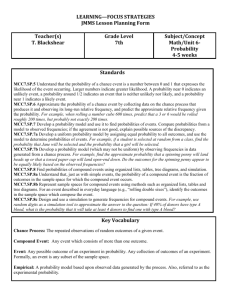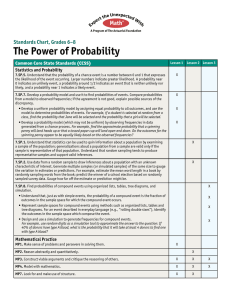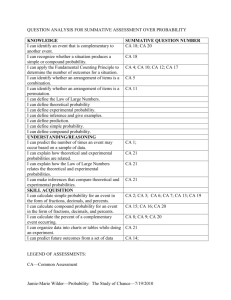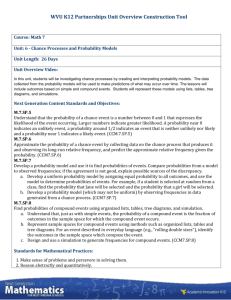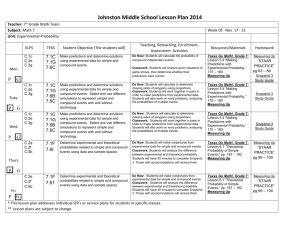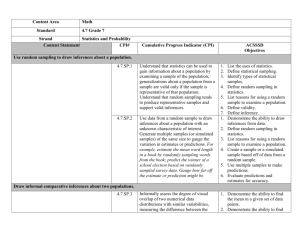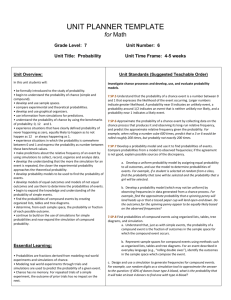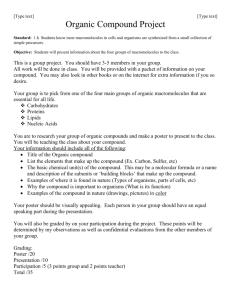can
advertisement
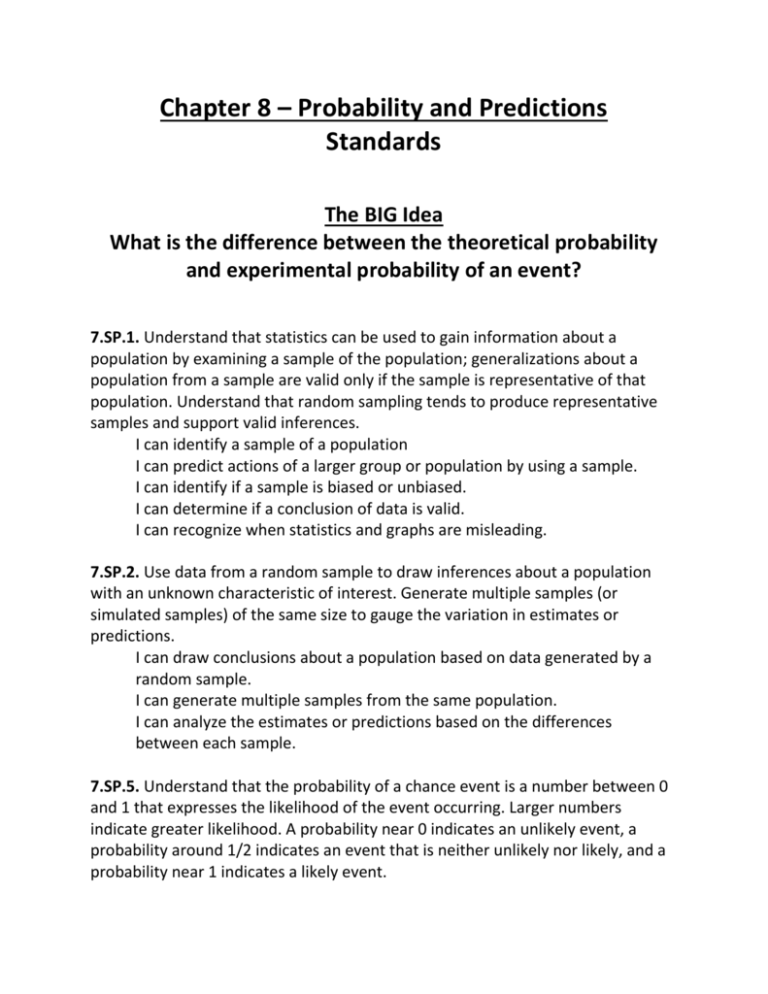
Chapter 8 – Probability and Predictions Standards The BIG Idea What is the difference between the theoretical probability and experimental probability of an event? 7.SP.1. Understand that statistics can be used to gain information about a population by examining a sample of the population; generalizations about a population from a sample are valid only if the sample is representative of that population. Understand that random sampling tends to produce representative samples and support valid inferences. I can identify a sample of a population I can predict actions of a larger group or population by using a sample. I can identify if a sample is biased or unbiased. I can determine if a conclusion of data is valid. I can recognize when statistics and graphs are misleading. 7.SP.2. Use data from a random sample to draw inferences about a population with an unknown characteristic of interest. Generate multiple samples (or simulated samples) of the same size to gauge the variation in estimates or predictions. I can draw conclusions about a population based on data generated by a random sample. I can generate multiple samples from the same population. I can analyze the estimates or predictions based on the differences between each sample. 7.SP.5. Understand that the probability of a chance event is a number between 0 and 1 that expresses the likelihood of the event occurring. Larger numbers indicate greater likelihood. A probability near 0 indicates an unlikely event, a probability around 1/2 indicates an event that is neither unlikely nor likely, and a probability near 1 indicates a likely event. I can identify all possible outcomes of an event. I can define probability as a ratio that compares favorable outcomes to all possible outcomes. I can recognize and explain that probabilites are expressed as a number between 0 and 1. I can interpret a probability close to 0 as unlikely to occur. I can interpret a probability of 0 as impossible to occur. I can interpret a probability close to 1 as likely to occur. I can interpret a probability close to 1/2 as equally likely to occur. I can write a probability as a percent, decimal or fraction. 7.SP.6. Approximate the probability of a chance event by collecting data on the chance process that produces it and observing its long-run relative frequency, and predict the approximate relative frequency given the probability. I can identify the differences and similarities between theoretical and experimental probability. I can find the theoretical and experimental probability of events. I can use the theoretical probability to predict what the experimental probability will be. 7.SP.7.a Develop a probability model and use it to find probabilities of events. Compare probabilities from a model to observed frequencies; if the agreement is not good, explain possible sources of the discrepancy. I can develop a simulation to model a situation where all events are equally likely to occur. I can use the simulation to determine the probability of specific events. 7.SP.7.b Content Expectation: b. Develop a probability model (which may not be uniform) by observing frequencies in data generated from a chance process. I can develop a simulation to model a situation where all events are not equally likely to occur. I can use the simulation to determine the probability of specific events. 7.SP.8.a Find probabilities of compound events using organized lists, tables, tree diagrams, and simulation. Content Expectation: a. Understand that, just as with simple events, the probability of a compound event is the fraction of outcomes in the sample space for which the compound event occurs. I can define probability of a compound event as a ratio that compares favorable outcomes to all possible outcomes. 7.SP.8.b Represent sample spaces for compound events using methods such as organized lists, tables and tree diagrams. I can create a sample space of all possible outcomes for a compound event by using an organized list, table, or tree diagram. I can identify all possible outcomes as a set (sample space) 7.SP.8.c Design and use a simulation to generate frequencies for compound events. For example, If 40% of donors have type A blood, what is the probability that it will take at least 4 donors to find one with type A blood? I can recognize if an event is independent or dependent. I can find the probability of an independent or dependent event. I can find the probability of disjoint events. Chapter 8 – Probability and Predictions Vocabulary Biased sample (voluntary and convenience) - A sample drawn in such a way that one or more parts of the population are favored over others. Complementary event The events of one outcome happening and that outcome NOT happening. The sum of the probabilities of an event and it complement is 1 or 100%. Combination A group of items or events. Placing these items or events in a different order does not create a new combination Compound event An event consisting of 2 or more simple events. Convenience sample A sample which consists of members of a population that are easily accessed Dependent event Two or more events in which the outcome of one event affects the outcome of the other event(s) Disjoint Events Events that cannot happen at the same time Experimental probability An estimated probability based on the relative frequency of positive outcomes occurring during an experiment It is based on what actually happened during the experiment Fair game A game where each player has an equally likely chance of winning Fundamental Counting Principle Uses multiplication of the number of ways each event in an experiment can occur to find the number of possible outcomes in a sample space. Geometric probability Using the principles of length and area to find the probability of an event Independent event Two or more events in which the outcome of one event does NOT affect the outcome of the other event(s) Odds in favor A ratio that compares the number of ways an event can occur to the number of ways the event cannot occur Outcome Any one of the possible results of an action. For example, 4 is an outcome when a number cube is rolled Permutation An arrangement, or listing, of objects in which order is important Population The entire group of items or individuals from which the samples under consideration are taken Probability The chance that some event will happen Probability = What you want to happen Total possible outcomes Random Outcomes occur at random if each outcome occurs by chance. Every outcome has an equal chance of happening Random sample A sample in which every person, object, or event in the population has an equal chance of being selected for the sample Relative frequency A ratio that compares the frequency of each category to the total Sample A randomly selected group chosen for the purpose of collecting data Sample space The set of all possible outcomes of a probability experiment Simple event One outcome or a collection of outcomes Simple random sample An unbiased sample where each item or person in the population is as likely to be chosen as any other. Survey A question or set of questions designed to collect data about a specific group of people, or population Systemic random sample A sample where the items or people are selected according to a specific time or item interval Theoretical probability Theoretical Prob. = The number of ways an event can occur The number of possible outcomes. It is based on what should happen when conducting an experiment Tree diagram A diagram used to show the sample space Unbiased sample (simple, stratified, and systemic) A sample representative of the entire population Unfair game A game where there is not a chance of each player being equally likely to win. Voluntary response system A sample which involves only those who want to participate in the sampling.
